Japan's Official Development Assistance White Paper 2011
(5) Disaster Reduction and Post-Disaster Reconstruction
Disasters caused by earthquakes, tsunamis, typhoons, floods, mudslides, and other natural events that occur frequently in countries around the world do not merely take human lives and properties. In developing countries that are vulnerable to disasters, poverty group suffer significant damage, and become disaster refugees in many cases. In addition, secondary damage such as the deterioration of sanitary conditions and food shortages may become long-term, making the problem more severe. In this manner, disasters have a significant impact on the overall social and economic mechanisms of developing countries.
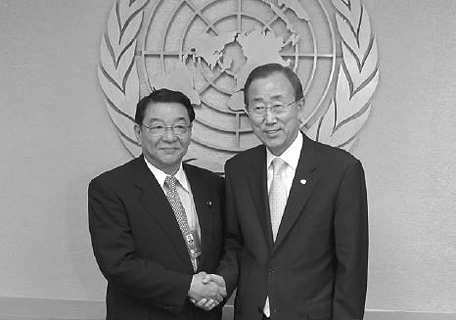
Parliamentary Senior Vice-Minister for Foreign Affairs Osamu Fujimura meets with United Nations Secretary-General Ban Ki-moon at a special session of the UN General Assembly related to flood damage in Pakistan
<Japan's Efforts>
Japan utilizes its superior expertise and technology acquired through past experiences with natural disasters like earthquakes and typhoons to provide proactive support in the areas of disaster prevention and post-disaster recovery, as well as emergency assistance. In 2005 at the second World Conference on Disaster Reduction in Kobe, the Hyogo Framework for Action 2005-2015 was adopted as a basic guideline for disaster reduction activities in the international community. Japan partners with the United Nations and other organizations to promote worldwide implementation.
At the conference, Japan also announced the Initiative for Disaster Reduction through ODA, which represents Japan's basic policy on cooperation in disaster risk reduction. Japan expressed its intent to continue proactive support the self-help efforts by developing countries toward building a disaster-resilient society through institution building, human resource development, development of economic and social infrastructure, and other measures.
•Japan Disaster Relief Team
Japan has established a structure to facilitate emergency assistance in response to requests from the government of a disaster-affected country or international organization, when major disaster damage has occurred. Japan utilizes four types of Japan Disaster Relief Team to provide humanitarian aid: (i) Search and Rescue Team to search and rescue victims, (ii) Medical Team to provide urgent medical assistance, (iii) Expert Team to give technical advice or guidance on disaster prevention and damage mitigation, and (iv) Self-Defense Force unit to be dispatched when it has been judged to be particularly necessary when a large-scale disaster has occurred. In addition, Japan provides emergency relief goods as material aid. Japan manages several warehouses in overseas with a stock of tents, generators, blankets, and other goods needed to enable victims to live for the immediate future, and Japan is always prepared to provide relief goods to affected countries when a disaster has occurred. In addition, to provide relief to victims and evacuees from natural disasters and conflicts, Japan disburses Emergency Grant Aid to the governments of a disaster-affected country and to the International organizations and Red Cross, which provide emergency assistance areas affected by disasters.
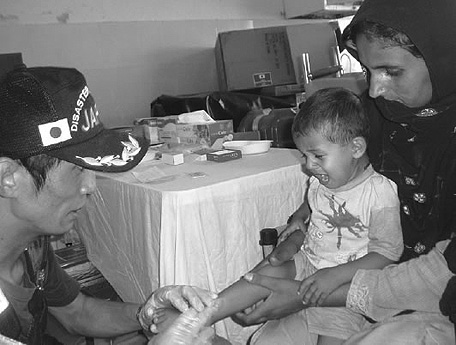
A member of the Japan Disaster Relief Medical Team tests for malaria as part of Japan's aid for flood damage in Pakistan (Photo: JICA)
In FY2010, Japan dispatched a total of 11 Japan Disaster Relief Teams to Pakistan, Indonesia, and New Zealand, and sent emergency relief goods on a total of 15 different occasions to 14 countries, including Myanmar, Haiti, Ghana, and Colombia. Also in FY2010, Japan provided approximately ¥4.5 billion in Emergency Grant Aid as emergency disaster assistance to a total of 12 countries, including Haiti, China, Chile, and Pakistan, and approximately ¥900 million in aid for democratization in Sudan and Haiti.
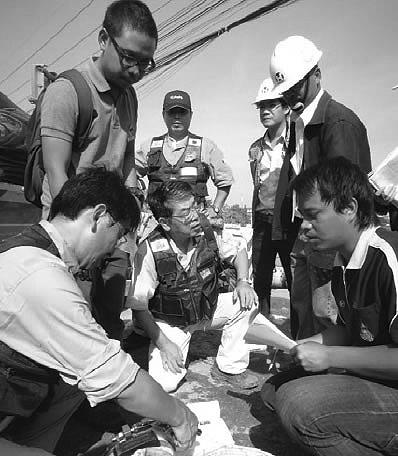
A Japanese experts instructs workers in Thailand about pump installation methods (Photo: JICA)

Japanese drain pump vehicles conducts work at industrial parks in Thailand. The drainage capacity of each truck is 30m3 per minute. (Photo: JICA)
•Collaboration with International Organizations
Japan provides cooperation to the "Global Facility for Disaster Reduction and Recovery" established in the World Bank in 2006. This Facility aims at supporting efforts to improve the ability for disaster preventing planning and post-disaster recovery in low and middle-income countries that are vulnerable to natural disasters.
With the increase in recognition of the importance of disaster reduction, representatives from UN organizations that are involved in disaster reduction in each country, the World Bank and other international organizations gathered at a meeting of the UN General Assembly in 2006. At the meeting, the Global Platform for Disaster Risk Reduction was established to facilitate discussions regarding disaster prevention. The first meeting of the Global Platform was held in June 2007. Japan proactively supports the activities of the UN International Strategy for Disaster Reduction (UN/ISDR), which serves as the secretariat for the Global Platform. The Hyogo Office of the UN/ISDR was opened in October 2007.
The third session of the Global Platform for Disaster Reduction was held in May 2011 in Geneva, Switzerland. More than 2,600 delegates representing 169 governments, 25 international organizations, 65 non-governmental organizations, private sector and civil society participated in the meeting. At the opening session, Mr. Shozo Azuma, Parliamentary Senior Vice-Minister for cabinet office, (in charge of relief), announced that Japan was willing to host the third World Conference on Disaster Reduction, and also stated that Japan was considering holding a high-level meeting in 2012 to share the experience of recent large-scale disasters. Six years have passed since the second meeting of the UN World Conference on Disaster Reduction in Kobe, so Japan is engaged proactively in follow-up to the Hyogo Framework for Action, which serves as the basic guideline for disaster risk reduction activities in the international community, while utilizing the forums provided by meetings of the Global Platform.
Japan is also helping the ASEAN Coordinating Centre for Humanitarian Assistance on Disaster Management (AHA Centre), which was launched in Jakarta, Indonesia, to contribute building a network for disaster-related information and dispatching experts.
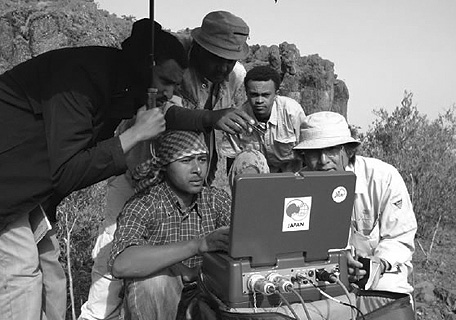
A Japanese expert gives instruction on underground exploration using a probe as part of the "Project for Developing Countermeasures against Landslide in the Abay River Gorge" in Ethiopia (Photo: JICA)
[Pakistan]
"Project for National Disaster Management Plan"
Technical Cooperation for Development Planning (March 2010 - Current)
Pakistan faces constantly by natural disasters such as floods, landslides, cyclones, and earthquakes. In October 2005, a major earthquake in northern Pakistan caused about 75,000 deaths of enormous damage. After the earthquake, the government of Pakistani reviewed its disaster planning that was for the aftermath. Pakistan has announced the National Disaster Management Ordinance and establishes the National Disaster Management Authority to take the lead in disaster management, because a national countermeasure is required to strengthen the disaster prevention structure focusing on prevention and mitigation. Through the technical cooperation including dispatch of experts based on the Japanese knowledge and experience of establishing legal systems and developing human resources, Japan supports the formulation of a national disaster management plan to serve as the basic guidelines for the concrete activities of the National Disaster Management Ordinance. Japan also supports improvement of a structure for disaster management in Pakistan led by National Disaster Management Authority (NDMA)*, as well as the development of the necessary human resources.
NDMA: National Disaster Management Authority
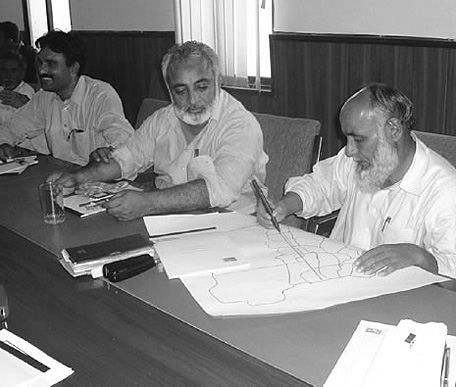
Disaster prevention staff members engage in group work on disaster prevention measures for their assigned regions (Photo: JICA)
[New Zealand]
"Dispatch of the Japan Disaster Relief Team in Response to the New Zealand Earthquake"
Japan Disaster Relief Team (February 23, 2011 - March 13, 2011)
A magnitude 6.3 earthquake hit southeast New Zealand on February 22, 2011 and caused significant damage around the city of Christchurch with 185 death including 28 Japanese, many of them are students from Toyama College of Foreign Languages. In response to the request by the government of New Zealand, Japan decided to dispatch the Japan Disaster Relief (JDR) Rescue teams, and provided effective and rapid assistance that met local needs such as search-rescue operations of the missing and mental healthcare of victims. On the airplane in New Zealand JDR Rescue Team were introduced in-flight announcements and received applause and warm encouragement from other passengers. The activities of JDR Rescue Team conducted thorough searches amidst worries of aftershocks received high praise and deep gratitude from the both government and people of New Zealand.
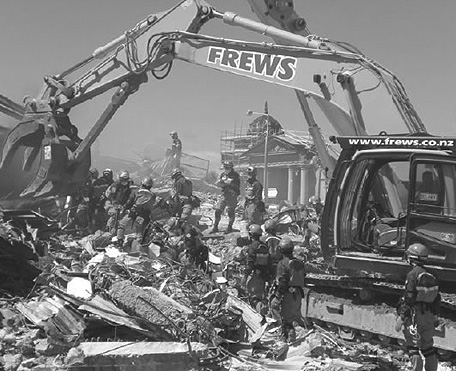
The Japan Disaster Relief Rescue Team searches a building in Christchurch with local authorities (Photo: JICA)
